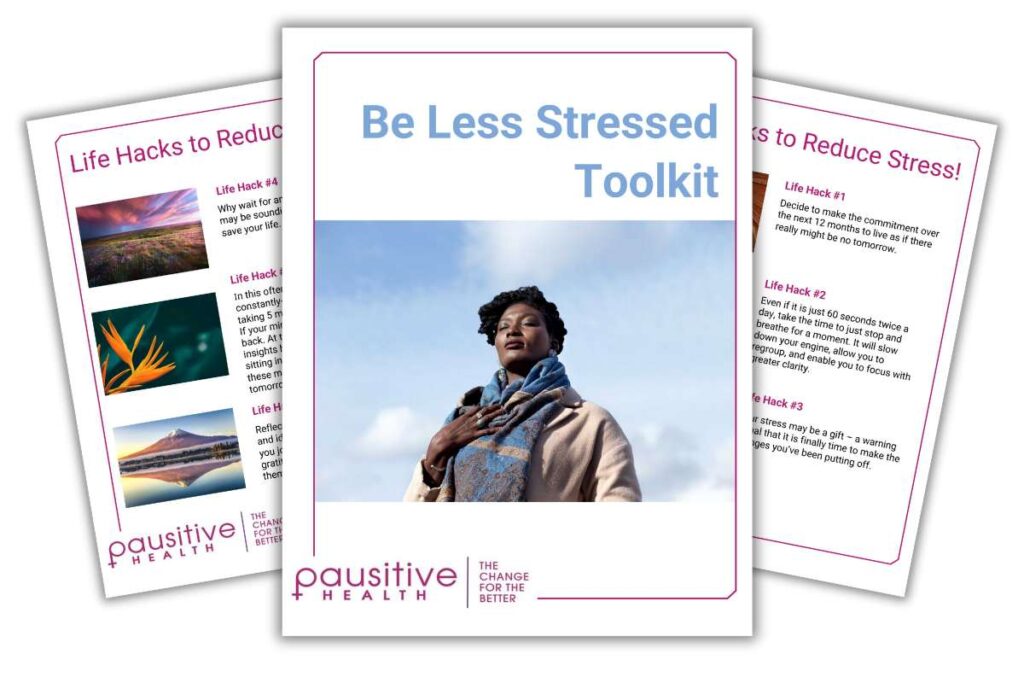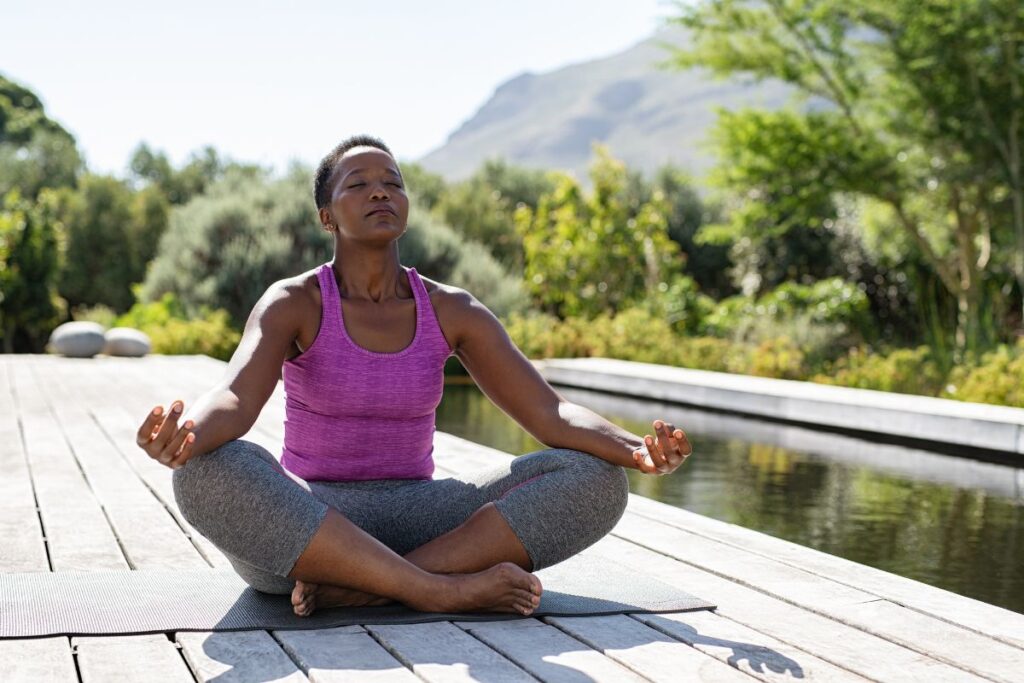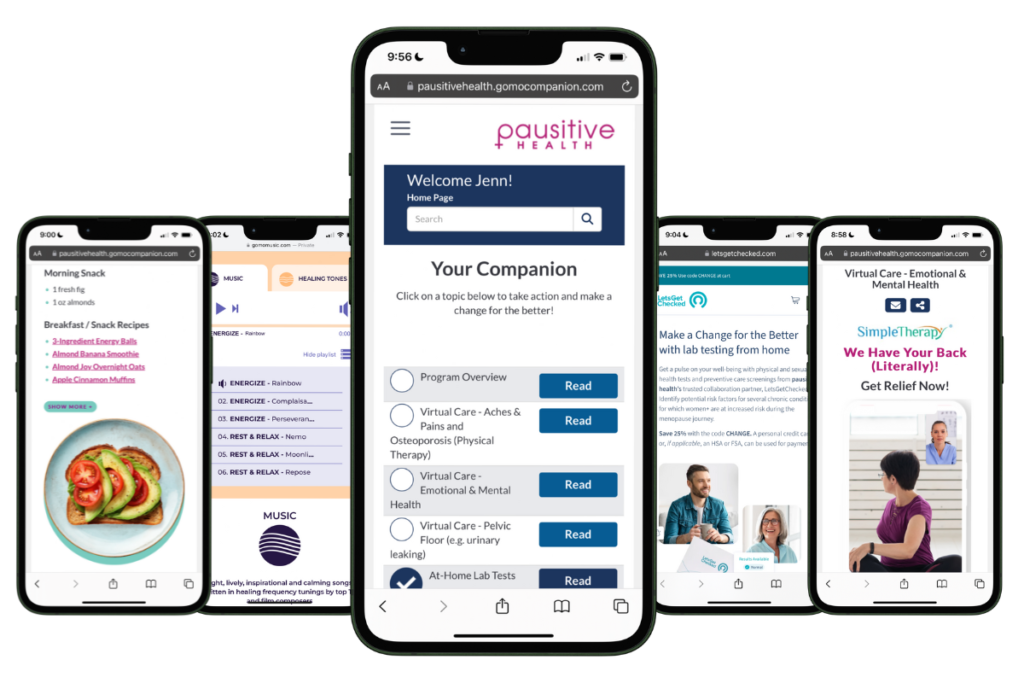During the menopause journey, you may find yourself stuck in your own head more than usual. From ruminating about relationships to tracking your hot flash triggers, changes linked to this life transition can distract you from the present. While feeling preoccupied is completely normal, you also have the power to make a shift any time, any day. One of our favorite tools to reset your state of being is mindfulness. It’s an accessible, non-hormonal option for easing symptoms such as hot flashes. Learn how to get started with mindfulness and how to appreciate the positive impact the menopause journey can have on your life today, tomorrow, and for the rest of your life.
What is mindfulness?
“Mindfulness godfather” Jon Kabat-Zinn defines mindfulness as “awareness by paying attention in the present moment non-judgmentally as if it really mattered.”
How often do you stop to pay attention to the present moment non-judgmentally?
There’s so much beauty waiting to be noticed — flowers in fresh bloom, your favorite song on the radio, a sunset over the ocean. We need to slow down to experience it.
“The secret to health for both mind and body is not to mourn the past, worry about the future, or anticipate troubles, but to live in the present moment wisely and earnestly.”
~ Buddha
Mindfulness vs. meditation
When you think of mindfulness, sitting still in a cross-legged seat may be the first thing that comes to mind.
While meditation and mindfulness are based on similar principles of connecting with ourselves and our surroundings, meditation is a way to practice mindfulness. On the other hand, mindfulness is a state of mind that we can access in any situation.
Both help us sharpen our focus and be present, become more self-aware, and strengthen emotional regulation. Like mindfulness, meditation can be practiced in many different ways, and we’ll explore some of these powerful methods later in this article.
How mindfulness can improve menopause symptoms
Mindfulness can positively impact your health and well-being in myriad ways, including the many physical and emotional health symptoms experienced by women+ during the menopause transition. For example, one study found that midlife women who reported higher mindfulness scores experienced fewer menopausal symptoms.
While some of its rewards might be felt at the end of your very first mindfulness session, knowing its long-term perks can help motivate you to invest the time to start and/or maintain a practice.
Mindfulness can help these symptoms and concerns during the menopausal journey:
- Stress
- Brain fog
- Emotional well-being
- Mindset
- Hot flashes
- Overcoming urges
- Chronic conditions
- Sleep
Mindfulness techniques can also help beyond the menopause journey with chronic pain, cancer, work and family emotional stress, and eating disorders.
Stress
Mindfulness has also consistently been shown to benefit many biomarkers like cortisol (the stress hormone) levels and C-reactive protein (CRP – a sign of inflammation in the body).
Many women+ find the menopause journey is filled with change, feelings of uncertainty, and often mixed emotions. And stress tends to be high, particularly in Black women+.
Chronic stress due to elevated cortisol levels can be damaging to the body, mind, and spirit.
Time and again, we hear about the negative impacts stress can have, like increasing the risk of:
- anxiety
- depression
- high blood pressure
- heart disease, heart attack, and stroke
Stress can also increase symptoms seen during the hormonal transition:
- weight gain
- aches and pains
- digestive issues
- headaches
- sleep problems
- “brain fog” (e.g., impairment of memory and concentration impairment)
Spending too much time worrying about the past and future can be draining—taking our attention from the many joys and inspirations life offers.
Overthinking can also make us more likely to experience anxiety and symptoms of depression. And lived experiences, which include being subject to systemic issues like discrimination, sexism, racism, health disparities, inequitable care, and medical gaslighting, can send stress levels skyrocketing, and our health begins to plummet.
Mindfulness exercises can also help get you out of a mental rut, gain greater perspective, and learn to cope and respond differently to harm in a way that can better protect you from its repercussions.

Be Less Stressed
Feeling stressed or overwhelmed? Learn life hacks to reduce stress with the Be Less Stressed toolkit.
"*" indicates required fields
Brain “fog” and mindfulness
While stress can exacerbate brain “fog” during the menopausal journey, you may also feel it on a good day. This can be a worrisome symptom if you lose your train of thought in the middle of a sentence or forget why you walked into a room.
The hormonal fluctuations in menopause impact your brain, and that’s why some women+ experience this symptom.
You can try herbs or techniques like mindfulness to improve this symptom. Consistent mindfulness has been shown to promote clarity and increase focus.
So, how much do you need? Aim for 10 minutes a day.
In a pausitive health webinar, Mindfulness Mentor Skylar Griessel talked about mindfulness and brain fog.
And, also provided other ways to combat it that are “mindfulness-adjacent” techniques. These include:
- Giving yourself 30 minutes in the morning to properly wake up
- Using positive self-talk and avoiding beating yourself up
- Creating a to do list and prioritizing things in A, B, and C categories
Healthy management of emotions
With all the new experiences and both the volatility and drops in estrogen and progesterone levels during the menopause journey, unfamiliar or intense emotions may come along as well. But mindfulness can help you accept these experiences without judgment rather than resist, suppress, or deny them.
In studies of menopause specifically, mindfulness was linked to less irritability, depression, and anxiety.
With the emotional volatility and sense of a lack of control some women experience during the hormonal transition, it can be tempting to self-medicate with alcohol and other substances. Although you may get relief in the moment, covering over what’s going on will only lead to avoidable, additional health issues in the future.
During a mindfulness webinar series, pausitive health Mindfulness Mentor, Skylar Griessel, talked about how affirmations can help improve self-esteem and emotional well-being.
Improved mindset
Mindfulness can also help you change your way of thinking. Take a moment to think about what your mindset is about menopause. Is it positive or negative?
By being mindful of the present, you can become more aware of your thoughts and feelings about your menopause symptoms without reacting to the hot flash or sleeplessness.
In the end, your mindset may change and become more positive, which in turn can also improve symptoms.
Mindfulness to improve hot flashes
Almost half (40%) of post-menopausal women report that vasomotor symptoms such as hot flashes and night sweats can negatively impact their daily lives. It can certainly be frustrating when symptoms arise at inopportune times, for example, during work, sex, or family time. And women+ with severe untreated hot flashes may also be at increased risk of cognitive decline and dementia as well as cardiovascular disease.
While hormonal therapy can be a beneficial treatment, it may not be preferred or ideal for all women. Luckily, mindfulness has also been shown to ease the experience of vasomotor symptoms.
One randomized trial, for example, found that Mindfulness Based Stress Reduction (MBSR), helped reduce the distress women experience from hot flashes. It also reduced the intensity of hot flashes.
Mindfulness-Based Stress Reduction, or MBSR, was first developed by Jon Kabat-Zinn at the University of Massachusetts Medical Center. It is typically an 8-week experience offered by a certified MBSR instructor and includes group discussion.
With MBSR, you learn to observe and be less reactive. For this trial, women+ did a body scan, sitting meditation, and mindful stretching exercises. They attended classes and informally practiced mindfulness between sessions.
Because VSM symptoms can be triggered by stress, these results may partly explain MSBR’s ability to mitigate stress.
So, whether you find that your hot flashes tend to arise during times of stress or want to feel less flustered by them, incorporating a mindfulness practice could help.
Practice mindfulness for hot flashes with these techniques
Watch this pausitive health webinar series from Skylar Griessel, Our Mindfulness Mentor! She walks you through three mindfulness techniques to make it easier to tolerate hot flashes.
Overcoming urges
Whether it’s smoking, eating processed foods heavy in salt, sugar, and fat, or being glued to our phones, it’s human to crave things that aren’t in line with our overarching goals. By allowing cravings to move through us, mindfulness can help us cope with urges for addictive substances or behaviors. When we recognize the feeling will pass, we can better avoid acting on it.
Chronic Conditions
The hormonal changes that come with menopause increase the risk of a host of chronic conditions:
- hypertension
- heart disease
- stroke
- diabetes
- osteoporosis
- depression
- anxiety
- overweight/obesity
- diabetes
- musculoskeletal aches and pains
Great news! In addition to hot flashes, MBSR has also been found to be helpful in the management of chronic conditions.
Want to learn more about it? Here’s a free online course you can take at your own pace to get grounded in what the practice is like.
Improved sleep
We’ve all had those nights where our minds seem to spin. But it’s possible to break the cycle and find calm. In fact, studies have found that mindfulness exercises improve the quality of sleep for post-menopausal women.
Simply slowing down and taking a moment to check in with yourself before hitting the pillow can help you fall asleep. Breath work and other meditative techniques that this article will describe in detail can also help you shift into a state of relaxation. Try a few of these:
- Bedtime Guided Meditation
- Pranayama 4-7-8 Breathing Exercise
- Body Scan
Practice this technique before bed
During a pausitive health webinar, our Mindfulness Mentor, Skylar Griessel, helped women+ practice breathing techniques to prepare their mind and body for sleep.
Benefits of mindfulness beyond the menopause journey
The positive impact of mindfulness is far-reaching beyond the conditions and symptoms discussed above. Additional health issues it’s been shown to benefit include:
- Chronic pain
- Cancer
- Work and family emotional stress
- Eating Disorders
There are even studies that suggest it can help protect our brains from cognitive decline.

How to practice mindfulness
One of the best parts of mindfulness? It’s always accessible. Below, we’re sharing some proven ways to incorporate mindfulness into your everyday life.
1. Start small
As with any new habit, you don’t have to do an overnight overhaul to make a difference. Mindfulness can be as simple as taking a moment to enjoy the scent of your coffee in the morning.
One great way to practice is by tuning into your environment. Whether you’re setting aside a few minutes in the evening or seeking relief in a moment of stress, take note of your sensations. What do you see and hear around you? How does the ground feel beneath your feet? Are you breathing or holding your breath a lot?
In stillness, you may be more aware of your emotions as well. Whatever you’re feeling, notice it without judgment. Instead, become curious, naming the emotions such as “sadness,” “joy,” “anger,” or “unease.”
Remind yourself this swirl of feelings is normal. Faced with ever-changing circumstances and stimuli, women+ have much to consider! But we also have the ability to gently redirect our thoughts, armed with the confidence that even the most difficult feelings will eventually pass if for no other reason than they become too exhausting to carry.
2. Mindful eating
Mindfulness doesn’t exist in a vacuum. It can also be brought to everyday activities such as mealtime. You can practice mindful eating.
How often is eating mindless? Do you do it because you feel hungry, or are you snacking throughout the day and consuming processed foods full of sugar, salt, and saturated fat? Do you focus on your food – the taste, smell, presentation on the plate, and consistency in your mouth – or are you scarfing it down and doing something else at the same time? Mindful eating can help you find joy in food beyond its nutritional benefits.
Mindful eating can also help address menopausal challenges like weight gain, which was one of the top concerns of women+ in a pausitive health survey. As you age, your metabolisms can slow down due to both changes in hormones and reduced muscle mass.
Additionally, mindful eating can help you build a healthier relationship with food. If you have intense feelings and look at it as the enemy (in a quest for an unrealistic and often unhealthy body image), mindful eating can help shift your thinking to view food as a way to fuel your body so you are nourished sufficiently to accomplish what you want or need to do.
With mindful eating, whether you’re eating alone or sharing a meal with loved ones, you tap into all of your physical and emotional senses. By appreciating and savoring the food, you’ll be able to increase your sense of gratitude. Taking this pause can also help you make nourishing choices that honor your body, mind, and spirit.
Next time you sit down for a meal, take a moment to evaluate your physical and emotional states. How hungry are you, or are you actually thirsty or simply eating out habit? Are there any negative emotions you’re seeking to avoid? With each bite, focus on your food’s smell, taste, and texture. Chew thoroughly, and feel free to set your fork between bites if you’re no longer in the present moment.
Throughout the meal, pause to re-evaluate your hunger levels. When you eat mindfully, you’re better able to notice when you’re full—instead of relying on an “empty plate” as the cue to be done.
Like any change, this may feel awkward and tedious at first, and you may want to move quickly through meals out of habit. But with practice, it will feel more intuitive, especially as you see how it benefits your well-being.
3.Yoga mindfulness
If you’re new to mindfulness, stillness may be uncomfortable. Gentle movement is one middle ground to help you quiet your thoughts.
The slow, steady pace of yoga is a prime setting for mindfulness. In addition to helping you build strength and flexibility, yoga emphasizes the connection between movement and breath. While the difficulty levels and types of yoga vary, some yoga forms sometimes involve holding poses, which can be a great way to practice getting comfortable with being uncomfortable. If you choose to attend a class, being in a calm space can help you connect with others and your deeper, shared humanity.
Note that not all yoga classes are supportive environments for mindfulness. Many focus on the exercise aspect by playing fast-paced music—not exactly the vibe for unwinding! Class tags like “slow flow” and “restorative” can be good clues about the ambiance. And don’t forget about the many options you can find online. Here are a few to get you started.
Yoga for Mindfulness Video
Yoga Nidra
pausitive health’s Mindfulness Mentor, Skylar Griessel, talked about how Yoga Nidra can help with menopausal symptoms during this webinar. That part of the discussion picks up at 11:23 and Griessel begins walking you through the 10 steps of Yoga Nidra at 19:45.
 Tai chi
Tai chi
A traditional Chinese martial art, tai chi has many benefits for mental and physical health. Like yoga, it prioritizes the relationship between movement and breath as you move gently and intentionally.
One of its goals is to create mind-body harmony. Plus, it doesn’t require equipment, so you can practice at home by watching videos or attending a class.
Tai chi also improves flexibility, balance, and muscle strength. Try these tai chi exercise videos.
Walking
One of the easiest—but no less effective—ways to practice mindful movement is walking. Choose a safe, calm place, such as a hiking trail or your neighborhood, put on comfortable shoes, and go for a stroll. The rhythm of your steps and the fresh air can be grounding.
As you walk, take note of your surroundings. Are there any new seasonal changes? How do your feet feel when they meet the sidewalk? Notice your thoughts, too, then let them pass like clouds in the sky.
While it’s a great time to tune into the sounds around you, there are also guided walking meditations online that you could listen to through headphones. And if the weather is rainy or too cold or there are no sidewalks in your neighborhood, “mall walking” or simply walking around the house may do the trick.

4. Find peace with meditation
Not to be confused with mindfulness itself, meditation is a great way to find presence, ease, and to practice mindfulness. And for women+ in menopause, it comes with added benefits: research shows a potential association between meditation and healthy blood chemistry.
While the traditional image of meditation is sitting still for a significant period of time, there’s no wrong way to meditate. That said, it can help to start out by sitting or lying down in a calm, quiet area. If you’re sitting, feel free to sit in a chair or on a pillow to maximize comfort.
Box breathing technique
The task to “just sit” can be difficult for some people. A good method to help you focus is breath work: specific breathing exercises that can help you relax physically and mentally. Often, we don’t notice how shallow our breath becomes—especially in times of stress.
Additionally, deep breathing boosts oxygen flow throughout our bodies, which can lower your heart rate and stabilize your blood pressure.
To get started, focus on the sensation of your breathing: the rise and fall of your belly, the flow of air through your nose.
Slowly, you can introduce a breath count. Box breathing is a great example. Simply:
- Inhale for four counts
- Out for four counts
- Exhale for four counts
- Out for four counts
- Repeat
A longer exhale has also been shown to promote relaxation.
Especially early on, there’s no need to force yourself to sit completely still. If you have an itch, move gently to scratch it; if you’re uncomfortable, you can shift. These sensations are natural, and the idea of mindfulness is to notice them without judgment and then gently return from the distraction.
4-7-8 breathing
This is a common breathing technique that is a go-to technique for women with panic attacks and anxiety. It’s an intentional practice that regulates the nervous system.
During a pausitive health webinar, Skylar Griessel, our Mindfulness Mentor, explained that with 4-7-8 breathing, you:
- Inhale through your nose for the count of 4.
- Then, hold your breath for a count of 7.
- Finally, you exhale through your mouth for a count of 8.
Why does this calm you? Griessel said the counting helps focus the mind on something other than your worries.
Over time, it can:
- improve sleep
- reduce symptoms of depression and anxiety
- provide mental clarity
- return you to baseline quicker after a normal stress response
Griessel said you can use this breathing technique when you’re in a stressful state. However, you should also practice it when you’re not stressed so you are ready to activate it when you need it. The discussion on this breathing technique starts at 24:40.
Body scan meditation
During menopause, you may be experiencing new joint aches and pains. A body scan can help you tune into those symptoms without judgment.
Before you go to sleep, lie on your back with your arms at your sides. You can do this on a yoga mat or even in bed. Beginning with your feet, focus on each part of your body for 20-30 seconds before moving upwards incrementally (for example, from foot to ankle, from ankle to calf, from calf to knee).
Note how each body part feels. Is it heavy, tense, relaxed? What emotions arise? You can also tense and relax each body part, ultimately working towards a feeling of full-body ease.
Here’s a guided body scan meditation to see if you like this technique.
Relax with guided imagery
Your environment impacts how you feel, but you can’t always go where you want. Maybe it’s been a long winter day in your city and all you’ve seen is gray. Maybe your house has gotten cluttered, and you want a way to retreat from the mess (while still working on organizing it over time).
Enter guided imagery, a relaxation technique that can transport you to a favorite, calming, or happy place.
Begin by closing your eyes and directing your thoughts to a happy place. Common examples include beaches, forests, or even your childhood home. What do you see? Is anyone there with you?
Try to envision the space in as much detail as you can: the smells, the sounds, the color of leaves, or the taste of spices in the cupboard. By helping your body remember a peaceful time, you can be better equipped to let go of negative thoughts and sensations.
Reduce your stress with this session by Jane Ehrman, MEd, RCHES, ACHT, Founder of Images of Wellness.
Visualization
Loving-kindness meditation
Loving-kindness meditation is the first set of 4 types taught by Buddha to develop and nurture positive emotions. The four types, called the 4 Brahma Viharas, are:
- Metta (loving-kindness)
- Karuna (compassion)
- Mudita (appreciative joy)
- Uppekha (equanimity)
Loving-kindness meditation is also known as “metta” meditation. It can be helpful during menopause if you are feeling badly about yourself, irritated with family/friends/colleagues, and/or are angry at the world in general. It is helpful in expanding our sense of gratitude and connectedness.
Traditionally, you begin with scripted phrasing directed at yourself. The same phrasing is then used but directed toward others. Then, it is repeated but directed toward all living beings globally. When saying the script, you visualize yourself, then others, and then the world in general. Some then extend it to the universe as a whole.
Loving-kindness meditation script
There are a multitude of scripts that can be used or edited. (You can also develop some of your own.) Here are a few to try:
How do I know if I’m doing it right?
While there are no set metrics for a “good” meditation session (in fact, it’s a time to dispense with those judgments!), many people describe a sense of effortless focus. You might experience fewer intrusive thoughts and a state of full-body peace.
It can take around 20 minutes to calm your mind through meditation fully. But if you’re just beginning, 5-10 minute periods are a great start for building the habit. And remember it’s called practice for a reason!
If you want added guidance or inspiration, there’s also a wealth of meditation videos online to explore. Below are a few:
5 Minute Loving-Kindness Meditation | Open Your Heart to Warmth and Loving Kindness
Loving-Kindness Meditation to Develop Mindfulness and Compassion
Making mindfulness a habit
Like any routine, making mindfulness part of your daily life takes time. The mind is like a muscle: the more you direct it in a certain way, the easier it becomes to reach that state.
To incorporate mindful moments, try setting reminders on your phone. Maybe it’s around mealtimes, bedtime, or when you tend to feel an afternoon slump.
You can also set SMART goals to develop a consistent mindfulness practice. SMART stands for Specific, Measurable, Achievable, Relevant, and Time-Bound. For example, maybe your goal is to eventually meditate for 20 minutes at least 3 times per week. That’s a specific and measurable goal.

Is it realistic? Maybe 20 minutes seems like 20 years at first. If a goal feels overwhelming, try breaking it down into a gradual progression: 5 minutes one week, 10 minutes the next, and finally, build up to 20. For this goal, you can set a deadline by which you hope to achieve it.
Once you’ve worked this habit into your routine, you may even find yourself enjoying mindful moments when you haven’t planned them: savoring the first rich bite of dark chocolate, catching a negative thought before it spirals, or pausing on your morning walk to feel the breeze.
The menopause journey starts much earlier than many realize and can be the perfect opportunity to focus on you and your health and well-being. It’s also a time to embrace new ways of managing symptoms, including non-hormonal approaches like mindfulness or a positive mindset.
Being focused, present, and living a healthy lifestyle can improve your overall health status and potentially reduce the severity of menopause symptoms. Mindfulness is a powerful way for you to make a change for the better that will pay dividends both now and well into the future!

Free Support
For Your Menopause Journey!
Only available for a limited time!
Access a one-stop menopause journey digital destination that provides personalized text messages that focus on educational topics you select and offers many other features such as a diet assessment with recommendations, solutions from collaboration partners to address menopausal aches and pains (the musculoskeletal syndrome of menopause – MSM), pelvic floor issues, virtual care, lifestyle tools, and a supportive community.
MBSR 8-Week Online Live | Center for Mindfulness
Greeson JM, Chin GR. Mindfulness and physical disease: a concise review. Curr Opin Psychol. 2019 Aug;28:204-210. doi: 10.1016/j.copsyc.2018.12.014. Epub 2018 Dec 27. PMID: 30785067; PMCID: PMC6597336.
González-Moret, R., Cebolla, A., Cortés, X. et al. The effect of a mindfulness-based therapy on different biomarkers among patients with inflammatory bowel disease: a randomised controlled trial. Sci Rep 10, 6071 (2020). https://doi.org/10.1038/s41598-020-63168-4
Mindfulness may ease menopausal symptoms | Mayo Clinic
Carmody JF, Crawford S, Salmoirago-Blotcher E, Leung K, Churchill L, Olendzki N. Mindfulness training for coping with hot flashes: results of a randomized trial. Menopause. 2011 Jun;18(6):611-20. doi: 10.1097/gme.0b013e318204a05c. PMID: 21372745; PMCID: PMC3123409.
Thurston R, Wu M, Chang Y, Aizenstein H, Derby C, Barinas-Mitchell E, Maki P. Menopausal Vasomotor Symptoms and White Matter Hyperintensities in Midlife Women. Neurology Jan 2023, 100 (2) e133-e141; DOI: 10.1212/WNL.0000000000201401
Zhu D, Chung HF, Dobson AJ, Pandeya N, Anderson DJ, Kuh D, Hardy R, Brunner EJ, Avis NE, Gold EB, El Khoudary SR, Crawford SL, Mishra GD. Vasomotor menopausal symptoms and risk of cardiovascular disease: a pooled analysis of six prospective studies. Am J Obstet Gynecol. 2020 Dec;223(6):898.e1-898.e16. doi: 10.1016/j.ajog.2020.06.039. Epub 2020 Jun 23. PMID: 32585222; PMCID: PMC7704910.
Niazi AK, Niazi SK. Mindfulness-based stress reduction: a non-pharmacological approach for chronic illnesses. N Am J Med Sci. 2011 Jan;3(1):20-3. doi: 10.4297/najms.2011.320. PMID: 22540058; PMCID: PMC3336928.
R. Sood, C. L. Kuhle, E. Kapoor, J. M. Thielen, K. S. Frohmader, K. C. Mara & S. S. Faubion (2019) Association of mindfulness and stress with menopausal symptoms in midlife women. Climacteric, 22:4, 377-382, DOI: 10.1080/13697137.2018.1551344
Brewer JA, Elwafi HM, Davis JH. Craving to quit: psychological models and neurobiological mechanisms of mindfulness training as treatment for addictions. Psychol Addict Behav. 2013 Jun;27(2):366-79. doi: 10.1037/a0028490. Epub 2012 May 28. PMID: 22642859; PMCID: PMC3434285.
Menopause Predisposes a Fifth of Women to Alzheimer’s | Scientific American
Niazi AK, Niazi SK. Mindfulness-based stress reduction: a non-pharmacological approach for chronic illnesses. N Am J Med Sci. 2011 Jan;3(1):20-3. doi: 10.4297/najms.2011.320. PMID: 22540058; PMCID: PMC3336928.
Benefits of Mindfulness | HelpGuide.org
Mehta R, Sharma K, Potters L, Wernicke AG, Parashar B. Evidence for the Role of Mindfulness in Cancer: Benefits and Techniques. Cureus. 2019 May 9;11(5):e4629. doi: 10.7759/cureus.4629. PMID: 31312555; PMCID: PMC6623989.
How Meditation Protects the Aging Brain from Decline | Mindful
Online Mindfulness-Based Stress Reduction (MBSR) | Palouse Mindfulness
Darehzereshki, S., Dehghani, F. & Enjezab, B. Mindfulness-based stress reduction group training improves of sleep quality in postmenopausal women. BMC Psychiatry 22, 254 (2022). https://doi.org/10.1186/s12888-022-03869-4
Yoga for Mindfulness | Cat Meffan [YouTube]
Sung MK, Lee US, Ha NH, Koh E, Yang HJ. A potential association of meditation with menopausal symptoms and blood chemistry in healthy women: A pilot cross-sectional study. Medicine (Baltimore). 2020 Sep 4;99(36):e22048. doi: 10.1097/MD.0000000000022048. PMID: 32899065; PMCID: PMC7478772.
Relaxation techniques: Breath control helps quell errant stress response | Harvard Health Publishing
What Is Box Breathing? | WebMD
Box breathing relaxation technique: how to calm feelings of stress or anxiety | Sunnybrook Hospital [YouTube]
10-min Body Scan (Lying Down) Mindfulness Practice | Angie Chew [YouTube]
How Guided Imagery Helps You Relax | Cleveland Clinic
Track 8 Autogenic Training | Jane Ehrman
Mind/Body Sessions with Jane | Images of Wellness
5 Minute Loving Kindness Meditation | Unearth Compassion [YouTube]
Loving Kindness Meditation to Develop Mindfulness and Compassion | Earth and Sky [YouTube]
Loving Kindness Meditation Script & Worksheet | Lived Experience Telephone Support System (LETSS)
Loving Kindness Meditation Script | Palouse Mindfulness
Loving Kindness Meditation Script | Penn Memory Center
You may also like…

Power Through Menopausal Changes with this RAIN Mindfulness Technique
The RAIN mindfulness technique can help you power through menopausal changes with a positive mindset. Read or listen to this script.

Missing Your Life Before Menopause? How to Manage The Grief and Loss
Do you ever think about life before menopausal symptoms? If you feel a sense of loss or grief, try these emotional coping strategies.

How Stress Affects Your Body and Makes Menopause Symptoms Worse
Did you know stress symptoms and menopausal symptoms are similiar?Learn how stress affects your body and how it can mkae menopause symptoms worse.

